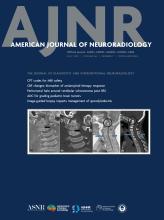Case of the Week
Section Editors: Matylda Machnowska1 and Anvita Pauranik2
1University of Toronto, Toronto, Ontario, Canada
2BC Children's Hospital, University of British Columbia, Vancouver, British Columbia, Canada
Sign up to receive an email alert when a new Case of the Week is posted.
April 27, 2017
Anterior Sacral Meningocele Related to Marfan Syndrome
- Background:
- Marfan sydrome is an autosomal dominant disease of the connective tissue that occurs in 1:10,000 live births, resulting from a mutation in the FBN1 gene on chromosome 15, which encodes for fibrillin-1.
- Dural ectasia is an enlargement of the dural sac or spinal canal that is present in 63–92% of adults with Marfan syndrome.
- Clinical Presentation:
- Many patients are asymptomatic.
- Can cause low back pain, radicular pain in buttocks or legs, leg weakness, or urinary incontinence
- Associated with spondylolisthesis, scoliosis, vertebral erosions, and vertebral fractures
- Key Diagnostic Features:
- Dilation of the dural sac, particularly between L1 and S1
- Posterior scalloping of vertebral bodies, thinning of the cortex of pedicles and laminae, widening of neural foramina, and meningocele are often noted.
- Differential Diagnoses:
- Sacrococcygeal teratoma: has soft tissue components and calcification; generally no communication with the spinal canal
- Neurenteric cyst: may be associated with vertebral anomalies; may be T1 hyperintense (protein); cyst within the spinal canal
- Nerve sheath tumors: generally solid, but can have cystic components; may remodel vertebral segments
- Pelvic mass of gastrointestinal, genitourinary, or gynecologic origin
- Treatment:
- Neurosurgical repair of dura if symptomatic











